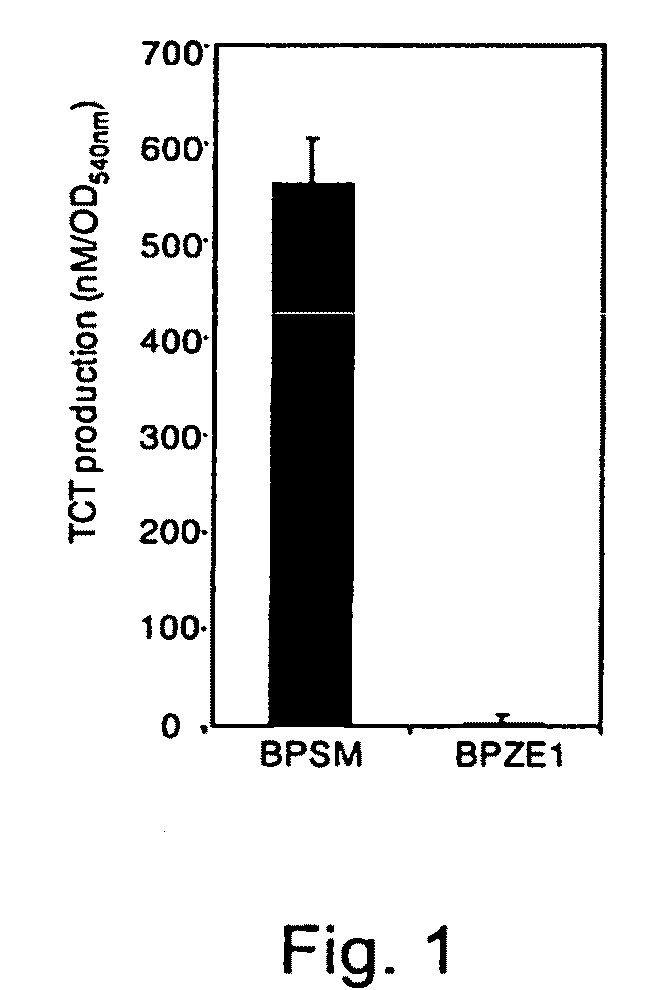Live Attenuated Bordetella Strains as a Single Dose Vaccine Against Whooping cough
- Summary
- Abstract
- Description
- Claims
- Application Information
AI Technical Summary
Benefits of technology
Problems solved by technology
Method used
Image
Examples
example 1
Bordetella Strains and Growth Conditions
[0103]The B. pertussis strains used in this study were all derived from B. pertussis BPSM [13], and B. parapertussis is a streptomycin-resistant derivative of strain 12822 (kindly provided by Dr. N. Guiso, Institut Pasteur Paris, France). All Bordetella strains were grown on Bordet-Gengou (BG) agar (Difco, Detroit, Mich.) supplemented with 1% glycerol, 20% defibrinated sheep blood, and 100 μg / ml streptomycin. For cell adherence assays, exponentially growing B. pertussis was inoculated at an optical density of 0.15 at 600 nm in 2.5 ml modified Stainer-Scholte medium [14] containing 1 g / l heptakis(2,6-di-o-methyl) β-cyclodextrin (Sigma) and supplemented with 65 μCi / ml L-[35S]methionine plus L-[35S]cysteine (NEN, Boston, Mass.) and grown for 24 h at 37° C. The bacteria were then harvested by centrifugation, washed three times in phosphate-buffered saline (PBS) and resuspended in RPMI 1640 (Gibco, Grand Island, N.Y.) at the desired density.
example 2
Construction of B. pertussis BPZE1
[0104]To construct B. pertussis BPZE1, the B. pertussis ampG gene was replaced by Escherichia coli ampG using allelic exchange. A PCR fragment named met and located at position 49,149 to 49,990 of the B. pertussis genome (http: / / www.sanger.ac.uk / Projects / B_pertussis / ), upstream of the B. pertussis ampG gene, was amplified using oligonucleotides A: 5′-TATAAATCGATATTCCTGCTGGTTTCGTTCTC-3′ (SEQ ID No:5) and B: 5′-TATAGCTAGCAAGTTGGGAAACGACACCAC-3′ (SEQ ID No:6), and B. pertussis BPSM [13] genomic DNA as a template. This 634 bp fragment was inserted into Topo PCRII (InVitrogen Life Technology, Groningen, The Netherlands) and then excised as a ClaI-NheI fragment and inserted into ClaI- and NheI-digested pBP23 [50], a suicide vector containing the E. coli ampG gene with flanking B. pertussis DNA of 618 bp (from position 50,474 to 51,092 of the B. pertussis genome) and 379 bp (from position 52,581 to 52,960 of the B. pertussis genome) at the 5′ and 3′ end of...
example 3
Analysis of TCT Production
[0107]For sensitive quantitation of TCT production, culture supernatants of B. pertussis grown to logarithmic phase were collected, subjected to solid phase extraction [15] and derivatized with phenylisothiocyanate (PITC, Pierce). The resulting phenylthiocarbamyl (PTC) derivatives were separated by reversed-phase HPLC using a C8 column (Perkin Elmer) and detected at 254 nm. The amount of B. pertussis PTC-TCT in each sample was determined by comparing the peak area and elution time with an identically processed TCT standard.
PUM
| Property | Measurement | Unit |
|---|---|---|
| Fraction | aaaaa | aaaaa |
| Fraction | aaaaa | aaaaa |
| Time | aaaaa | aaaaa |
Abstract
Description
Claims
Application Information
 Login to View More
Login to View More - R&D
- Intellectual Property
- Life Sciences
- Materials
- Tech Scout
- Unparalleled Data Quality
- Higher Quality Content
- 60% Fewer Hallucinations
Browse by: Latest US Patents, China's latest patents, Technical Efficacy Thesaurus, Application Domain, Technology Topic, Popular Technical Reports.
© 2025 PatSnap. All rights reserved.Legal|Privacy policy|Modern Slavery Act Transparency Statement|Sitemap|About US| Contact US: help@patsnap.com



